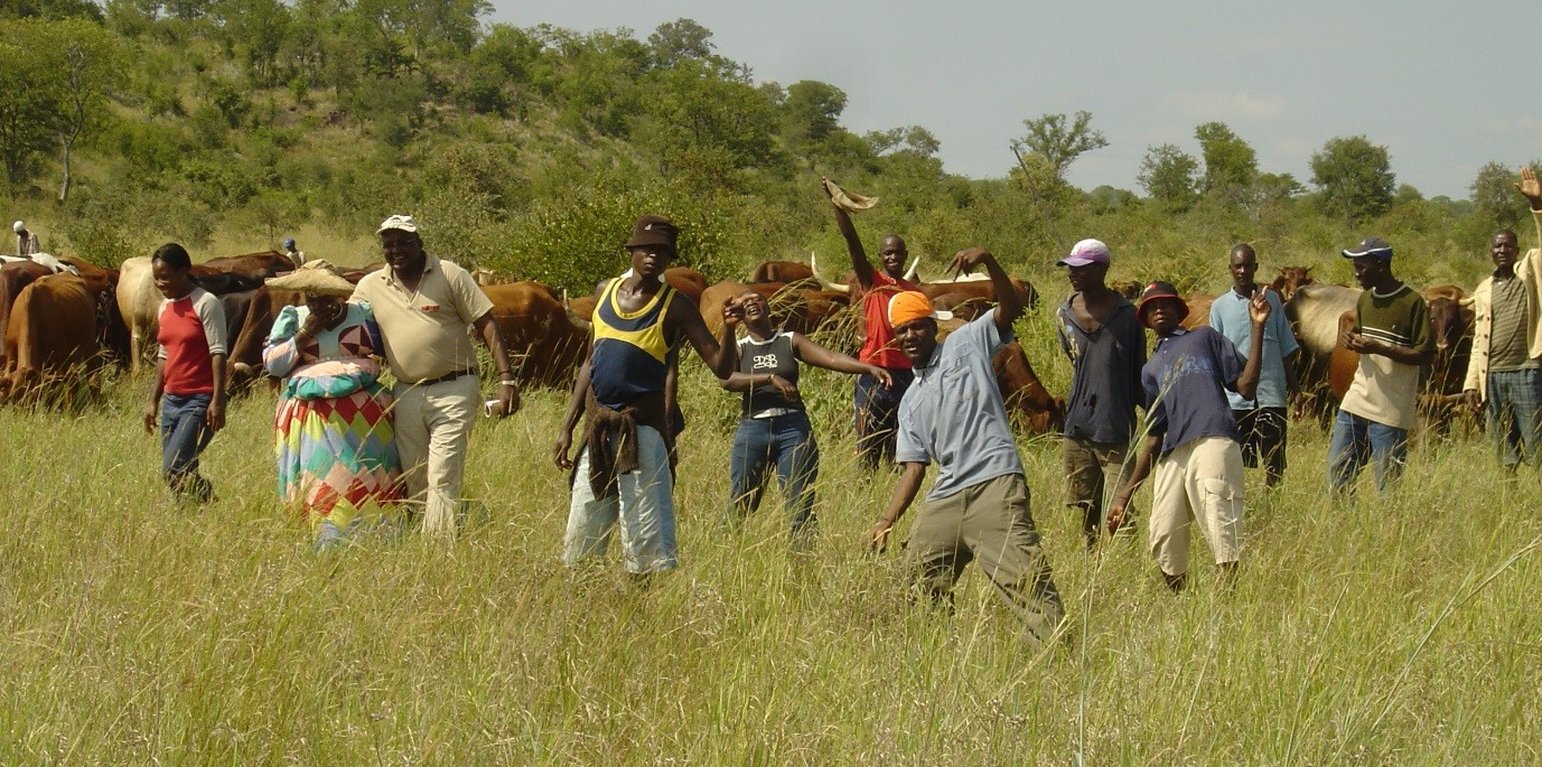



The approach is a partnership between an NGO, Ministry of Land Reform (MLR), Ministry of Agriculture , Water and Forestry (MAWF), the National Farmers Union (NNFU), traditional authorities, and regional and local government. The NGO raises awareness among the community about the damage caused to the rangeland by individual herds of livestock grazing continuously – and to appreciate the benefits of planned grazing. Livestock owners invite facilitators to compare the current state of their land with that of the past. The reasons for the decline are investigated. Once livestock owners understand that perennial grasses need recovery, they soon conclude that their management caused the loss of perennial grass and the increase in bare ground. At this point, the aim of the approach can be pursued. This is to regenerate rangeland productivity in the communal grazing area and thereby support higher livestock production. This in turn supports livelihoods.
If motivation to apply planned grazing exists among the community members, then their right to claim common property ownership needs to be established. In pioneering communities this requires at least 10 village level livestock owner meetings to decide on modalities of planned grazing. These meetings continue after planned grazing has started to deal with ongoing planning, animal production and marketing. Exposure visits to areas with successful grazing management help. On return frequent follow-up meetings, facilitated by the NGO and the MAWF, can resolve local issues, including traditional taboos, such as combining animals in one kraal, and whose bulls should be kept and managed.
Boundaries with neighbouring communities need to be mapped, recognised and respected by all. In case of grass poaching, the offenders must to be swiftly dealt with, preferably through customary law. A grazing plan needs to be agreed by all livestock owners, and endorsed by the local Traditional Authority. The grazing area (GA) is then mapped, while six herders, one of whom is their manager, are appointed from among the community though common agreement. Each livestock owner pays a portion of the herding and management cost pro-rata based on the number of his livestock. At night the cattle are separated and kraaled near the homesteads of their owners. In the morning, the herders collect cattle from the kraals. Different portions of the grazing area are grazed daily and only returned to when the grass has replenished its root reserves - some months later.
The process started at Erora in 2004, facilitated by the NGO, Integrated Rural Development and Nature Conservation (IRDNC). Implementation began in 2006, combining approximately 1200 cattle from 12 households. Livestock owners noticed a higher density of annual grasses after the first season; dramatic improvement in soil cover after three years with emergence of grass seedlings where none had grown for decades. Then after another three years, perennial grasses returned with increased biodiversity in many parts. However, when the extended drought started in 2011, planned grazing was interrupted and gullies expanded, down which rainwater flowed, dehydrating the rangelands. The drought lasted for five years, and the planned grazing was temporarily discontinued in 2013. During this period, rehabilitation work included constructing bush filters along key gullies: facilitation was taken over by another NGO, Conservation Agriculture Namibia (CAN). After successive years of severe drought, cattle became too weak to be rounded up, and in 2014 the community members decided to revert to keeping cattle near their homesteads. This was intended to be temporary but cattle only gained sufficient strength in 2017. The communal grazing management approach was extended to other villages in 2012, despite the drought. New boreholes were drilled and installed to facilitate improved planned grazing.
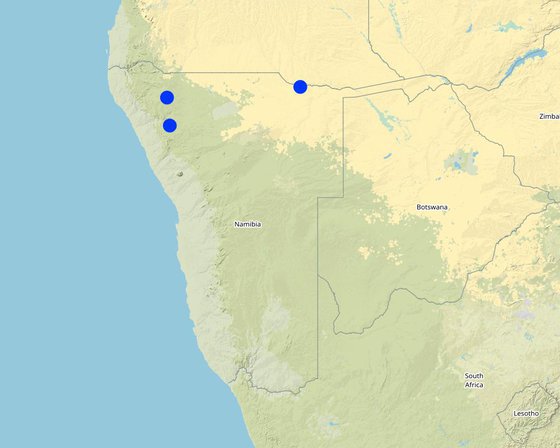
ទីតាំង: Erora village, 18.32637 South, 14.05912 East, Kunene Region, ប្រទេសណាមីប៊ី
កាលបរិច្ឆេទចាប់ផ្តើម: 2004
ឆ្នាំបញ្ចប់: មិនមាន
ប្រភេទនៃវិធីសាស្ត្រផ្សព្វផ្សាយ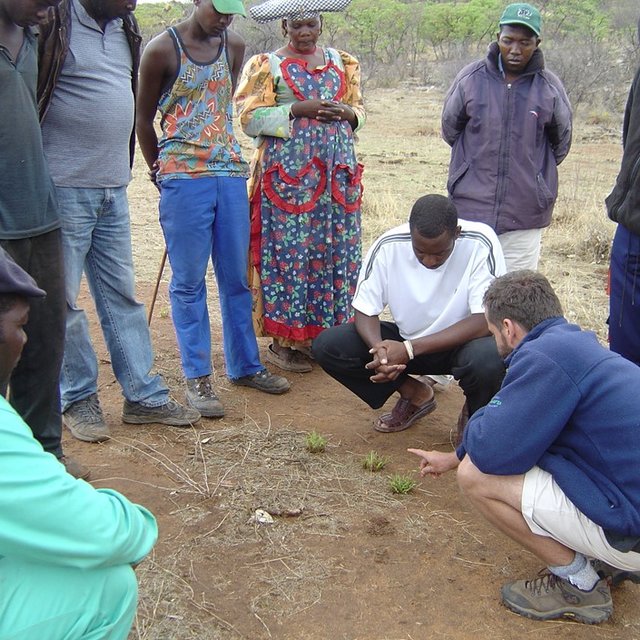
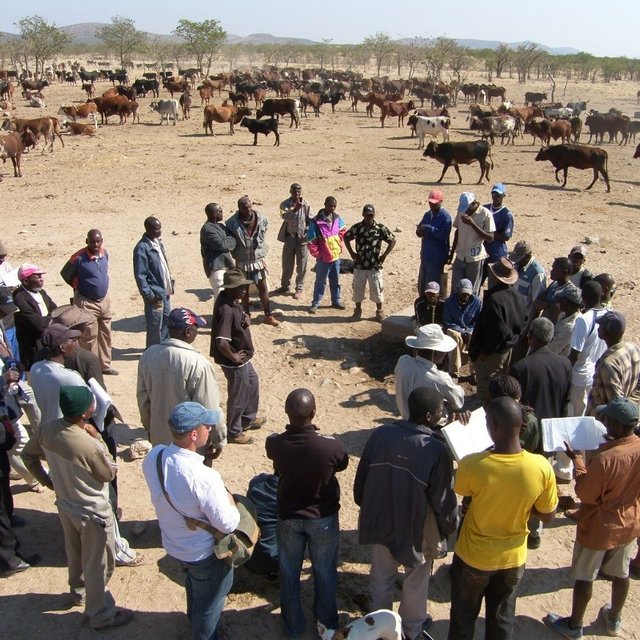
| តើមានភាគីពាក់ព័ន្ធ/ភ្នាក់ងារអនុវត្តន៍ណាខ្លះដែលបានចូលរួមក្នុងវិធីសាស្ត្រផ្សព្វផ្សាយ? | សូមបញ្ជាក់ភាគីពាក់ព័ន្ធ | សូមពណ៌នាតួនាទីរបស់ភាគីពាក់ព័ន្ធ |
| អ្នកប្រើប្រាស់ដីក្នុងតំបន់/សហគមន៍ | Communities of Erora, Outokotorua and Nsindi | To organise, plan and implement |
| អង្គការសហគមន៍មូលដ្ឋាន | Grazing Committee | Oversee day to day implementation |
| អ្នកឯកទេសគ្រប់គ្រងដីប្រកបដោយចីរភាព/ទីប្រឹក្សាបច្ចេកទេសកសិកម្ម | Integrated Rural Development and Nature Conservation (IRDNC), then Conservation Agriculture Namibia (CAN) and Namibia National Farmers Union (NNFU) | To facilitate adoption and upscaling of the approach |
| អ្នកស្រាវជ្រាវ | United States Department of Agriculture (USDA) | To assess rangeland condition changes |
| អង្គការក្រៅរដ្ឋាភិបាល | First IRDNC, then CAN | To facilitate the approach |
| វិស័យឯកជន | Zakumuka Producers Cooperative | To organise auctions for sale of livestock |
| រដ្ឋាភិបាលថ្នាក់មូលដ្ឋាន | Traditional authorities | To support and enable agreed rules |
| រដ្ឋាភិបាលថ្នាក់ជាតិ (អ្នករៀបចំផែនការ អ្នកសម្រេចចិត្ត) | Namibian Ministries of Lands & Agriculture | Assist with facilitation and support |
| Farmers union | Namibia National Farmers Union | Enabling policy and legislation |
Flow chart of the process to facilitate community grazing management.
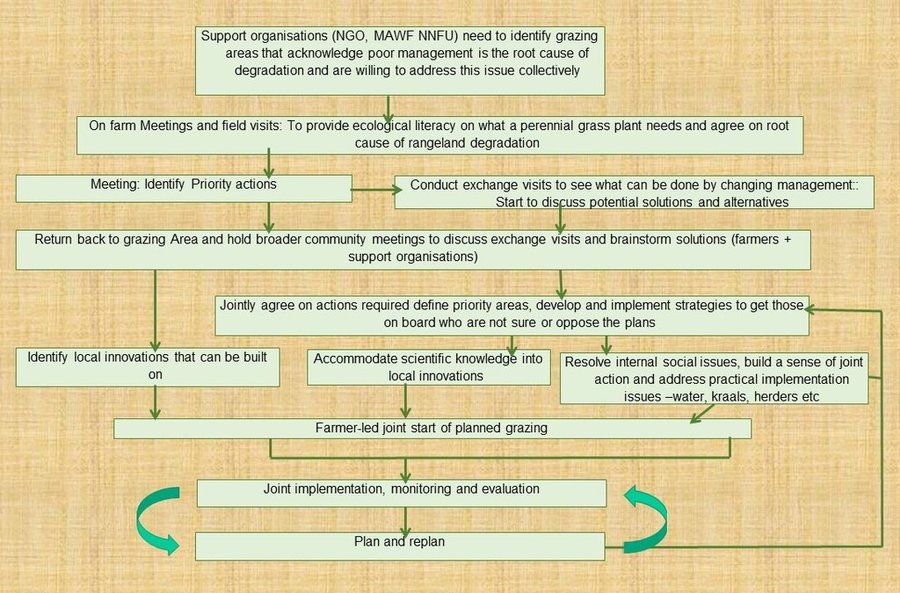
ការសម្រេចចិត្តត្រូវបានធ្វើដោយ
ការសម្រេចចិត្តត្រូវបានធ្វើដោយផ្អែកលើ៖
On farm(s) exploration of root cause of degradation based on how it was in the past and how it looks now and why this change has happened.
USDA/IPA came to evaluate rangelands and consult key stakeholders
Part payment to herders 2004-2007 in Erora only
Erora upgrade USD 10 000, second solar borehole half funded by community USD 10 000. Lion proof kraal funded by Africat – USD 2 000
កំលាំងពលកម្មដោយអ្នកប្រើប្រាស់ដីគឺ
Through the whole approach.
Through observations by herders and livestock owners.
Combined herding through planned grazing.
Key stakeholders are all involved.
Training provided the skills to self organise and implement activities based upon identification of root cause of land degradation.
Ministries of Agriculture and Lands.
Key stakeholders are all collaborating, since the solution to rangelands cuts across various sectors.
Reinstated sense of community
Women-headed households now have their livestock herded communally.
Women-headed households now have their livestock herded communally.
Herders are mainly youth and young livestock owners, who appreciate improved rangeland and are now willing to remain.
The willingness to address appropriate land rights may initiate resolution of land issues.
Much during good rains and little during drought.
Access to borehole water was provided.
Solar installations were installed or replaced diesel where possible for pumping of water.
Improved grass growth in good rain years and improved survival in drought.
Herders and managers were appointed.
They mobilise themselves, appoint herders, do the implementation, do the planning jointly and, and only asking for some technical support.